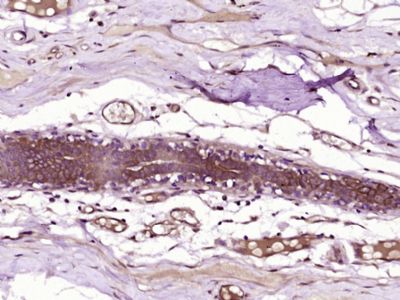C19orf28 Polyclonal Antibody
Purified Rabbit Polyclonal Antibody (Pab)
- 产品详情
- 实验流程
Application
| IHC-P, IHC-F, IF, ICC, E |
|---|---|
| Primary Accession | Q6NUT3 |
| Reactivity | Human |
| Host | Rabbit |
| Clonality | Polyclonal |
| Calculated MW | 52075 Da |
| Physical State | Liquid |
| Immunogen | KLH conjugated synthetic peptide derived from human MFSD12/C19orf28 |
| Epitope Specificity | 351-450/480 |
| Isotype | IgG |
| Purity | affinity purified by Protein A |
| Buffer | 0.01M TBS (pH7.4) with 1% BSA, 0.02% Proclin300 and 50% Glycerol. |
| SUBCELLULAR LOCATION | lysosomal membrane |
| Important Note | This product as supplied is intended for research use only, not for use in human, therapeutic or diagnostic applications. |
| Background Descriptions | C19orf28, also known as PP3501, is a multi-pass membrane protein that belongs to the major facilitator superfamily. The gene encoding C19orf28 localizes to chromosome 19 and, due to alternative splicing events, C19orf28 exists as two isoforms. Consisting of around 63 million bases with over 1,400 genes, chromosome 19 makes up over 2% of human genomic DNA. Chromosome 19 includes a diversity of interesting genes and is recognized for having the greatest gene density of the human chromosomes. It is the genetic home for a number of immunoglobulin superfamily members including the killer cell and leukocyte Ig-like receptors, a number of ICAMs, the CEACAM and PSG family, and Fc receptors. Key genes for eye color and hair color also map to chromosome 19. Peutz-Jeghers syndrome, spinocerebellar ataxia type 6, the stroke disorder CADASIL, hypercholesterolemia and insulin-dependent diabetes have been linked to chromosome 19. Translocations with chromosome 19 and chromosome 14 can be seen in some lymphoproliferative disorders and typically involve the proto-oncogene BCL3. The C19orf28 gene product has been provisionally designated C19orf28 pending further characterization. |
| Gene ID | 126321 |
|---|---|
| Other Names | Major facilitator superfamily domain-containing protein 12, MFSD12 {ECO:0000303|PubMed:29025994, ECO:0000312|HGNC:HGNC:28299} |
| Dilution | IHC-P=1:100-500,IHC-F=1:100-500,ICC=1:100-500,IF=1:100-500,ELISA=1:5000-10000 |
| Format | 0.01M TBS(pH7.4) with 1% BSA, 0.09% (W/V) sodium azide and 50% Glyce |
| Storage | Store at -20 °C for one year. Avoid repeated freeze/thaw cycles. When reconstituted in sterile pH 7.4 0.01M PBS or diluent of antibody the antibody is stable for at least two weeks at 2-4 °C. |
| Name | MFSD12 {ECO:0000303|PubMed:29025994, ECO:0000312|HGNC:HGNC:28299} |
|---|---|
| Function | Transporter that mediates the import of cysteine into melanosomes, thereby regulating skin pigmentation (PubMed:33208952, PubMed:37751742). In melanosomes, cysteine import is required both for normal levels of cystine, the oxidized dimer of cysteine, and provide cysteine for the production of the cysteinyldopas used in pheomelanin synthesis, thereby regulating skin pigmentation (PubMed:33208952). Also catalyzes import of cysteine into lysosomes in non-pigmented cells, regulating lysosomal cystine and cysteine storage, which is essnetial for redox homeostasis (PubMed:33208952, PubMed:37751742). |
| Cellular Location | Melanosome membrane; Multi-pass membrane protein. Lysosome membrane; Multi-pass membrane protein |
| Tissue Location | Widely expressed, with high expression in primary melanocytes. |
Research Areas
For Research Use Only. Not For Use In Diagnostic Procedures.
Application Protocols
Provided below are standard protocols that you may find useful for product applications.
终于等到您。ABCEPTA(百远生物)抗体产品。
点击下方“我要评价 ”按钮提交您的反馈信息,您的反馈和评价是我们最宝贵的财富之一,
我们将在1-3个工作日内处理您的反馈信息。
如有疑问,联系:0512-88856768 tech-china@abcepta.com.
¥ 1,500.00
Cat# AP59342























 癌症的基本特征包括细胞增殖、血管生成、迁移、凋亡逃避机制和细胞永生等。找到癌症发生过程中这些通路的关键标记物和对应的抗体用于检测至关重要。
癌症的基本特征包括细胞增殖、血管生成、迁移、凋亡逃避机制和细胞永生等。找到癌症发生过程中这些通路的关键标记物和对应的抗体用于检测至关重要。 为您推荐一个泛素化位点预测神器——泛素化分析工具,可以为您的蛋白的泛素化位点作出预测和评分。
为您推荐一个泛素化位点预测神器——泛素化分析工具,可以为您的蛋白的泛素化位点作出预测和评分。 细胞自噬受体图形绘图工具为你的蛋白的细胞受体结合位点作出预测和评分,识别结合到自噬通路中的蛋白是非常重要的,便于让我们理解自噬在正常生理、病理过程中的作用,如发育、细胞分化、神经退化性疾病、压力条件下、感染和癌症。
细胞自噬受体图形绘图工具为你的蛋白的细胞受体结合位点作出预测和评分,识别结合到自噬通路中的蛋白是非常重要的,便于让我们理解自噬在正常生理、病理过程中的作用,如发育、细胞分化、神经退化性疾病、压力条件下、感染和癌症。






